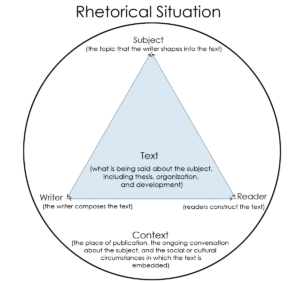This week you’ll begin injecting into this conversation about diversity and inclusion that we’ve been reading about. Each of you will suggest an article to add to this body of information, so that we can all continue to expand our understanding of the issues. Please be sure to reread the last page of the unit 1 assignment sheet.
First, a quick refresher on rhetorical situation. This is the idea that everything is written by someone, for someone, for some purpose, and within some broader context. Considering these different elements of a text can give us a window into how the text works, why it looks the way it does, whether it is likely to be successful for its intended reader, etc. You’ve already seen rhetorical situation represented in visual form like this:

Just a little something to keep in mind as we move into discussion for the week–we’ll be thinking a lot this week about how authors respond to their writing situation in order to produce successful communications, and in particular about how an author’s audience connects to his/her purpose in writing.
On to the prompts–this week everyone should respond to the 1st question and then select 1 of the other 2 to answer. Responses should be >150 words each. Please tag your responses with “unit1,” “weekof6/1,” and [your name]. Categorize as “Discussions.”
- It’s time to get moving along with your unit 1 assignment. For this assignment, you will be adding to the set of sources we’re reading about diversity and organizational culture (which amount to a canon of sorts–a collection of important texts). We’ll expand this canon by suggesting additional valuable resources. So, for your first discussion post this week, please tell us a little about how you’re doing that: what kinds of material are you looking for? what topic are you following up on? what sort of expert(s) do you think we need to hear from? how are you looking (i.e. what particular databases or search tools are you using)? what techniques or strategies are proving helpful?
- This week’s readings move from the theoretical conversation about diversity that unfolds in the pages of scholarly journals to the practical–consideration of what is actually involved in creating and maintaining a diverse workforce, this time through the lens of (dis)ability. Let’s start to put the pieces together, as we’re adding to our growing foundation of knowledge: construct a they say/I say sentence (or series of sentences) that connects one of this week’s readings about disability inclusion with one of the readings from the last 2 weeks. (There are a number of templates in chapter 2 of TSIS that might help you with this work.) You are welcome to include yourself as an I in this formulation, but you may also choose to use 2 theys here–i.e. While Austin and Pisano contend that…. Kaplan and Donovan suggest that… Be creative, and use this work to further your understanding both of the texts you’re employing, as well as your own perspective.
- In chapter 1 of Rewriting, Joe Harris asks us to consider a writer’s project when we’re trying to make sense of a particular text. That is, he encourages us to think of “something far more complex than a main idea, since it refers not to a single concept but to a plan of work, to a set of ideas and questions that a writer ‘throws forward (Latin, pro + jacare)” and to recognize that “a project is something that a writer is working on–and that a text can only imperfectly realize” (Harris 17). Thinking in these terms, how would you characterize the project that Kaplan and Donovan undertake in “Key D&I Concepts”? That is, what do you think they are “working on” in this article? (Review Harris’s steps at the bottom of page 15.)
